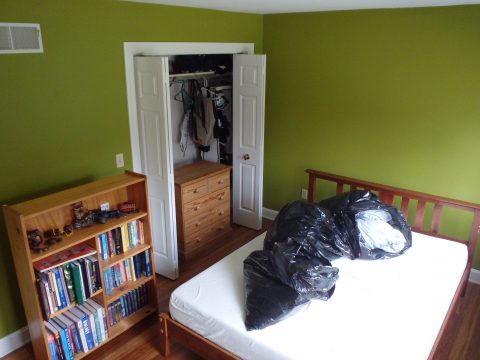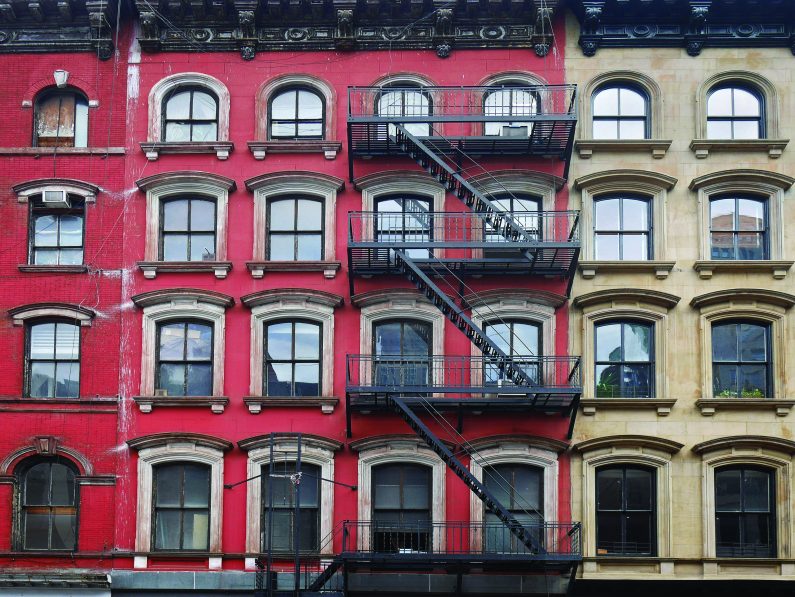Click here to view the printable document.
Recommendations for remediation and ongoing proactive servicing
This protocol assumes that some active infestations exist in the building. Inspections of each unit can be conducted at the time of scheduled treatment, this saves time, and active infestations are identified and treated immediately. All units will be treated, so all residents must be given notice in advance, and must arrange to leave their units for 4 hours. Specific protocols for infested and un-infested units are provided below.
Residents may remain in the unit until the pest control technicians arrive. No specific preparation is required, but where possible, floor areas should be cleared of dirty clothing and clutter so the technicians can move around the unit easily. The technicians will conduct a rapid assessment of the bed and living room seating to determine if an active bed bug infestation is present. If bed bug activity is found, the technicians will strip the bedding from the bed. This bedding will be handed to the resident who must arrange for the pillows and comforters to be placed in a drier and dried at high heat for at least 40 mins. All sheets and pillow cases should be washed and dried at high heat. This task can be conducted immediately on leaving the unit. The laundered and dried bedding can be re-placed on the bed by the tenant on their return to the unit. If the tenant is not present at the time of arrival of the pest control technicians, the bags containing bedding should be left sealed with clear instructions that they must be laundered and dried before replacing on the beds. Ideally this information will have been distributed beforehand by the management so that tenants are aware that this task is required.

Where no evidence of infestation is found, the bedding will be removed from the bed by the technicians, but laundering will not be required, this is optional if the resident would like to do this during the period when they have to vacate the unit.
Treatment protocol for units with active infestations
- Strip all bedding from the bed and place in a large black trash bag for laundering. Hand the bags to the residents and provide written guidance on laundering protocol for infested bedding.
- Use a HEPA filtered vacuum to remove all visible bed bugs, skins, and eggs from the bed, living room furniture and any other areas where bed bugs or bed bug activity is visible. Pay particular attention to the mattress, bed frame, box spring, and couches and recliners.
- Identify infested items such as shoes, items stored under the bed etc. These items can be vacuumed to remove live activity or/if possible, a hot-box can be used to heat treat these items (see details below).
- Apply primary Aprehend barriers. Primary barriers go around sites where people spend their time: external and internal perimeters of the bed frame and box spring, the bottom perimeter of box springs and couches etc., the top perimeter of box springs and the inner seating area of couches. Spray the sides of couch cushions .
- Apply secondary Aprehend barriers. Secondary barriers go around sites where bed bug harborages or access points
to the unit are suspected. These barriers are only required for units with active infestations. Apply secondary barriers around all furniture with suspected bed bug harborages, these include dressers, closets, and around door and window moldings, baseboards, around electrical outlets and air vents that connect units. NOTE. Do not apply Aprehend inside electrical outlets or air vents. - Encase mattress or use vacuum, steam or any approved chemical product before replacing the mattress on the box spring or bed frame. Ensure that the mattress is dry before placing on surfaces treated with Aprehend.
- Return to the unit approximately 30 days later to inspect for live bed bugs.
- If any live activity is found, re-apply primary barriers of Aprehend around bed, seating areas, and vents that connect units. If no live activity is present around secondary areas, no need to re-apply here.
Treatment protocol for un-infested units
- Strip all bedding from the bed and place in a large black trash bag. Residents may choose to launder their bedding, but this should not be required.
- Apply primary Aprehend barriers around external and internal perimeters of the bed frame and box spring, around the bottom perimeter of box springs and couches etc., the top perimeter of box springs and the inner seating area of couches. Spray the sides of couch cushions before replacing them on the couch. Mattresses do not need to be treated in un-infested apartments.
- Apply secondary Aprehend barriers around air vents that connect units and around the internal and external door frame of the entrance to the unit.
- Return after approximately 3 months to reapply proactive primary barriers.
Treatment protocol for laundry rooms and other communal areas
- Treat baseboards and wall/ceiling interface in hallways.
- Treat laundry rooms with barriers wherever bed bugs may walk or harbor.
- Apply barriers around inside and outside door frames.
- Treat base boards and underneath seating in common room and library.
Hot box treatment for special items
e.g.: https://www.zappbug.com/product/the-zappbug-oven-2/ Cost = US $349.99 (invaluable!)
- Wheelchairs and walking assistance devices—it is very common for these items to become infested. The most effective method of de-infestation is to heat the item in a hot box.
- Shoes and other non-washable items can also be placed in the hot box.
- Pillows and comforters could also be heated in this box if the dryer in the laundry is not available.
Important measures to be implemented going forwards
- Outside cleaners must not bring vacuum cleaners into the building. These could harbor bed bugs from other premises.
- Units with new residents must be inspected and treated with Aprehend within one week of move-in.
- No second-hand furniture to be brought into the building after initial move-in unless inspected and treated by Pest Control before installation in the unit.
- All residents should be educated on indicators of infestation, instructions on notifying management immediately if bed bug activity is noticed, and a very clear warning that NO PESTICIDES may be applied by residents inside the building for ANY reason.
Estimating cost of service
- Proactive treatment of an un-infested 1 bedroom apartment will take 2 technicians 10 minutes and use approximately 3 oz. of Aprehend.
- Treatment of an infested 1 bedroom apartments will take 2 technicians approximately 20 mins and use 4 oz. Aprehend.
- Factor in the 30 day follow up for infested units (ensure eradication before moving these units to quarterly servicing).
- Schedule quarterly servicing anticipating most units will be un-infested and only require pro-active treatment moving forward.
See how other PMPs have used Aprehend in a variety of difficult situations in these Case Studies and suggested prep steps and proper equipment usage with these Training Videos .
Or give us a call at (800) 891-8610 and we can discuss how to integrate Aprehend into your current protocol, reduce call-backs, and eliminate the most difficult bed bug infestations.

